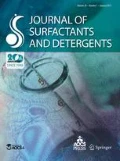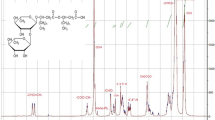Abstract
A comparative analysis of rhamnolipids from environmental isolates of Pseudomonas aeruginosa was undertaken to evaluate strain-specific rhamnolipid fingerprints obtained under different growth conditions. Environmental isolates of P. aeruginosa produced rhamnolipids on different types of substrates, including cheap and renewable sources like sunflower oil from deep fryers and sunflower oil mill effluent. Rhamnolipids were monitored by high-performance liquid chromatography–electrospray ionization interface mass spectrometry, which allowed fast and reliable identification and quantification of the congeners present. The highest concentration of total rhamnolipids of 3.33 g/l was obtained by the strain P. aeruginosa 67, recovered from petroleum contaminated soil, and strains D1 (1.73 g/l) and D2 (1.70 g/l), recovered from natural microbial consortia originated from mazut-contaminated soil, grown on sunflower oil as a carbon source. Di- to mono-rhamnolipids ratios were in the range of 0.90–5.39 for different media composition and from 1.12 to 4.17 for different producing strains. Rhamnolipid profiles of purified mixtures of all tested strains are similar with chain length from C8–C12, pronounced abundance of Rha–C10–C10 and Rha–Rha–C10–C10 congeners, and a low content of 3-(3-hydroxyalkanoyloxy)-alkanoic acids. Concentrations of major congeners of RLs were found to slightly vary, depending on strain and growth conditions, while variations in minor congeners were more pronounced. Statistically significant increase of critical micelle concentration values was observed with lowering the ratio of total mono- to di-rhamnolipids ratio indicating that mono-rhamnolipids start to form micelles at lower concentration than di-rhamnolipids.
Similar content being viewed by others
References
Abdel-Mawgoud AM, Lépine F, Déziel E (2010) Rhamnolipids: diversity of structures, microbial origins and roles. Appl Microbiol Biotechnol 86:1323–1336
Chayabutra C, Wu J, Ju LK (2001) Rhamnolipid production by Pseudomonas aeruginosa under denitrification: effects of limiting nutrients and carbon substrates. Biotechnol Bioeng 72:25–33
Lépine F, Déziel E, Milot S, Villemur R (2002) Liquid chromatographic/mass spectrometric detection of the 3-(3-hydroxyalkanoyloxy) alkanoic acid precursors of rhamnolipids in Pseudomonas aeruginosa cultures. J Mass Spectrom 37:41–46
Boles BR, Thoendel M, Singh PK (2005) Rhamnolipids mediate detachment of Pseudomonas aeruginosa from biofilms. Mol Microbiol 57:1210–1223
Davey ME, Caiazza NC, O’Toole GA (2003) Rhamnolipid surfactant production affects biofilm architecture in Pseudomonas aeruginosa PAO1. J Bacteriol 185:1027–1036
Schooling SR, Charaf UK, Allison DG, Gilbert P (2004) A role for rhamnolipid in biofilm dispersion. Biofilms 1:91–99
Tremblay J, Richardson AP, Lepine F, Déziel E (2007) Self-produced extracellular stimuli modulate the Pseudomonas aeruginosa swarming motility behaviour. Environ Microbiol 9:2622–2630
Aparna A, Srinikethan G, Smitha H (2012) Production and characterization of biosurfactant produced by a novel Pseudomonas sp. 2B. Colloids Surf B 95:23–29
Maier RM (2003) Biosurfactants: evolution and diversity in bacteria. Adv Appl Microbiol 52:101–121
Nie M, Yin X, Ren C, Wang Y, Xu F, Shen Q (2010) Novel rhamnolipid biosurfactants produced by a PAH-degrading bacterium P. aeruginosa strain NY3. Biotechnol Adv 28:635–643
Müller MM, Hörmann B, Kugel M, Syldatk C, Hausmann R (2011) Evaluation of rhamnolipid production capacity of Pseudomonas aeruginosa PAO1 in comparison to the rhamnolipid over-producer strains DSM 7108 and DSM 2874. Appl Microbiol Biotechnol 89:585–592
Górna H, Lawnicazak Ł, Zgoła-Greśkowiak A, Kaczorek E (2011) Differences and dynamic changes in cell surface properties of three Pseudomonas aeruginosa strains isolated from petroleum-pollutes soil as a response to various carbon sources and the external addition of rhamnolipids. Biores Technol 10:3028–3033
Haba E, Abalos A, Jauregui O, Espuny MJ, Manresa A (2003) Use of liquid chromatography-mass spectroscopy for studying the composition and properties of rhamnolipids produced by different strains of Pseudomonas aeruginosa. J Surf Deterg 6:155–161
Haba E, Pinazo A, Jauregui O, Espuny MJ, Infante MR, Manresa A (2003) Physicochemical characterization and antimicrobial properties of rhamnolipids produced by Pseudomonas aeruginosa 47T2 NCIB 40044. Biotechnol Bioeng 81:316–322
Costa SGVAO, Nitschke M, Haddad R, Eberlin MN, Contiero J (2006) Production of Pseudomonas aeruginosa LBI rhamnolipids following growth on Brazilian native oils. Process Biochem 41:483–488
Dubeau D, Déziel E, Woods DE, Lépine F (2009) Burkholderia thailandensis harbors two identical rhl gene clusters responsible for the biosynthesis of rhamnolipids. BMC Microbiol 9:263–274
Mata-Sandalova JC, Karns J, Torrens A (2001) Effect of nutritional and environmental conditions on production and composition of rhamnolipids by P. aeruginosa UG2. Microbiol Res 155:249–256
Basu A, Apte SK, Phale PS (2006) Preferential utilization of aromatic compounds over glucose by Pseudomonas putida CSV86. Appl Environ Microbiol 72:2226–2230
Lăzăroaie MM (2009) Investigation of saturated and aromatic hydrocarbon resistance mechanisms in Pseudomonas aeruginosa IBBML1. Cent Eur J Biol 4:469–481
Makkar RS, Cameotra SS, Banat IM (2011) Advances in utilization of renewable substrates for biosurfactant production. ABM Express 1:5. doi:10.1186/2191-0855-1-5
Das K, Mukherjee AK (2005) Characterization of biochemical properties and biological activities of biosurfactants produced by Pseudomonas aeruginosa mucoid and non-mucoid strains isolated from hydrocarbon-contaminated soil samples. Appl Microbiol Biotechnol 69:192–199
Das K, Mukherjee AK (2007) Crude petroleum-oil biodegradation efficiency of Bacillus subtilis and Pseudomonas aeruginosa strains isolated from a petroleum-oil contaminated soil from north-east India. Bioresour Technol 98:1339–1345
Chrzanowski Ł, Ławniczak Ł, Czaczyk K (2012) Why do microorganisms produce rhamnolipids? World J Microbiol Biotechnol 28:401–419
Moore ERB, Tindal BJ, Martins Dos Santos VAP, Pieper DH, Ramos JL, Palleroni NJ (2006) In: Dworkin M, Falkow S, Rosenberg E, Schleifer KH, Stackebrandt E (eds), Nonmedical Pseudomonas. The prokaryotes. Springer, New York, pp 646–703
Benincasa M, Abalos A, Oliveira I, Manresa A (2004) Chemical structure, surface properties and biological activities of the biosurfactant produced by Pseudomonas aeruginosa LBI from soapstock. Antonie Van Leeuwenhoek 85:1–8
Noordman WH, Janssen DB (2002) Rhamnolipid stimulates uptake of hydrophobic compounds by Pseudomonas aeruginosa. Appl Environ Microbiol 68:4502–4508
Abalos A, Pinazo A, Infante MR, Casals M, Garcia F, Manresa A (2001) Physicochemical and antimicrobial properties of new rhamnolipids produced by Pseudomonas aeruginosa AT10 from soybean oil refinery wastes. Langmuir 17:1367–1371
Wei Y-H, Chou C-L, Chang J-S (2005) Rhamnolipid production by indigenous Pseudomonas aeruginosa J4 originating from petrochemical wastewater. Biochem Engin J 27:146–154
Bafghi MK, Fazaelipoor MH (2012) Application of rhamnolipid in the formulation of a detergent. J Surf Deterg 15:679–684
Jovancicevic B, Antic M, Pavlovic I, Vrvic M, Beskoski V, Kronimus A, Schwarzbauer J (2008) Transformation of petroleum saturated hydrocarbons during soil bioremediation experiments. Water Air Soil Pollut 190:299–307
Beskoski VP, Gojgic-Cvijovic G, Milic J, Ilic M, Miletic S, Solevic T, Vrvic MM (2011) Ex situ bioremediation of a soil contaminated by mazut (heavy residual fuel oil)—a field experiment. Chemosphere 83:34–40
Karadzic I, Masui A, Fujiwara N (2004) Purification and characterization of a protease from Pseudomonas aeruginosa growth in cutting oil. J Biosci Bioeng 98:145–152
Clark KG, Ballot F, Reid SJ (2010) Enhanced rhamnolipid production by Pseudomonas aeruginosa under phosphate limitation. World J Microbiol Biotechnol 26:2179–2184
Löser C, Seidel H, Zehnsdorf A, Stottmeister U (1998) Microbial degradation of hydrocarbon in soil during aerobic/anaerobic change and under purely aerobic conditions. Appl Microbiol Biotechnol 49:631–636
Siegmund I, Wagner F (1991) New method for detecting rhamnolipids excreted by Pseudomonas species during growth on mineral agar. Biotechnol Tech 5:265–268
Gunther NW, Nunez A, Fett W, Solaiman DKY (2005) Production of rhamnolipids by Pseudomonas chlororaphis, a nonpathogenic bacterium. App Environ Microbiol 71:2288–2293
Chandrasekaran EV, BeMiller JN (1980) In: Whistler RL (ed) Methods in carbohydrate chemistry. Academic Press, New York, pp 89–96
Heyd M, Kohnert A, Tan TH, Nusser M, Kirschhöfer F, Brenner-Weiss G, Franzreb M, Berensmeier S (2008) Development and trends of biosurfactant analysis and purification using rhamnolipids as an example. Anal Bioanal Chem 39:1579–1590
Wang Q, Fang X, Bai B, Liang X, Shuler PJ, Goddard WA, Tang Y (2007) Engineering bacteria for production of rhamnolipid as an agent for enhanced oil recovery. Biotechnol Bioeng 98:842–853
Bharali P, Konwar BK (2011) Production and physico-chemical characterization of a biosurfactant produced by Pseudomonas aeruginosa OBP1 isolated from petroleum sludge. Appl Biochem Biotechnol 146:1444–1460
Déziel E, Lépine F, Dennie D, Boismenu D, Mamer OA, Villemur R (1999) Liquid chromatography/mass spectrometry analysis of mixtures of rhamnolipids produced by Pseudomonas aeruginosa Strain 57RP grown on mannitol or naphthalene. Biochim Biophys Acta 1440:244–252
Dimitrijevic A, Velickovic D, Rikalovic M, Avramovic N, Milosavic N, Jankov R, Karadzic I (2011) Simultaneous production of exopolysaccharide and lipase from extremophilic Pseudomonas aeruginosa san-ai strain: a novel approach for lipase immobilization and purification. Carbohyd Polym 83:1397–1401
Karadzic I, Masui A, Izrael-Zivkovic L, Fujiwara N (2006) Purification and characterization of an alkaline lipase from Pseudomonas aeruginosa isolated from putrid mineral cutting oil as metal working fluid. J Biosc Bioeng 102:82–89
Abdel-Mawgoud AM, Hausmann R, Lépine F, Müller MM, Denziel E (2011) In: Chávez S (ed) Biosurfactants, microbiology monographs 20. Springer, Berlin. doi:10.1007/978-3-642-14490-5_2
Miller RM (1995) Surfactant-enhanced bioavailability of slightly soluble organic compounds. In: H.D. Skipper HD, Turco RF (eds) Bioremediation: Science and Applications. Soil Science Society of America Madison (USA) 1995, pp 322–354
Mata-Sandoval JC, Karns J, Torrents A (1999) High-performance liquid chromatography method for the characterization of rhamnolipid mixtures produced by Pseudomonas aeruginosa UG2 on corn oil. J Chromatogr A 864:211–220
Zhang Y, Maier WJ, Miller RM (1997) Effect of rhamnolipids on the dissolution, bioavailability, and biodegradation of phenanthrene. Environ Sci Technol 31:2211–2217
Acknowledgments
This work was supported by the project III 43004 of the Ministry of Science and Technological Development of Serbia and by Natural Sciences and Engineering Research Council of Canada (NSERC) Discovery Grant No. 312478 to ED. The authors thank Dr Lidija Izrael-Zivkovic for her assistance in data processing.
Author information
Authors and Affiliations
Corresponding author
Electronic supplementary material
Below is the link to the electronic supplementary material.
About this article
Cite this article
Rikalovic, M.G., Abdel-Mawgoud, A.M., Déziel, E. et al. Comparative Analysis of Rhamnolipids from Novel Environmental Isolates of Pseudomonas aeruginosa . J Surfact Deterg 16, 673–682 (2013). https://doi.org/10.1007/s11743-013-1462-4
Received:
Accepted:
Published:
Issue Date:
DOI: https://doi.org/10.1007/s11743-013-1462-4




